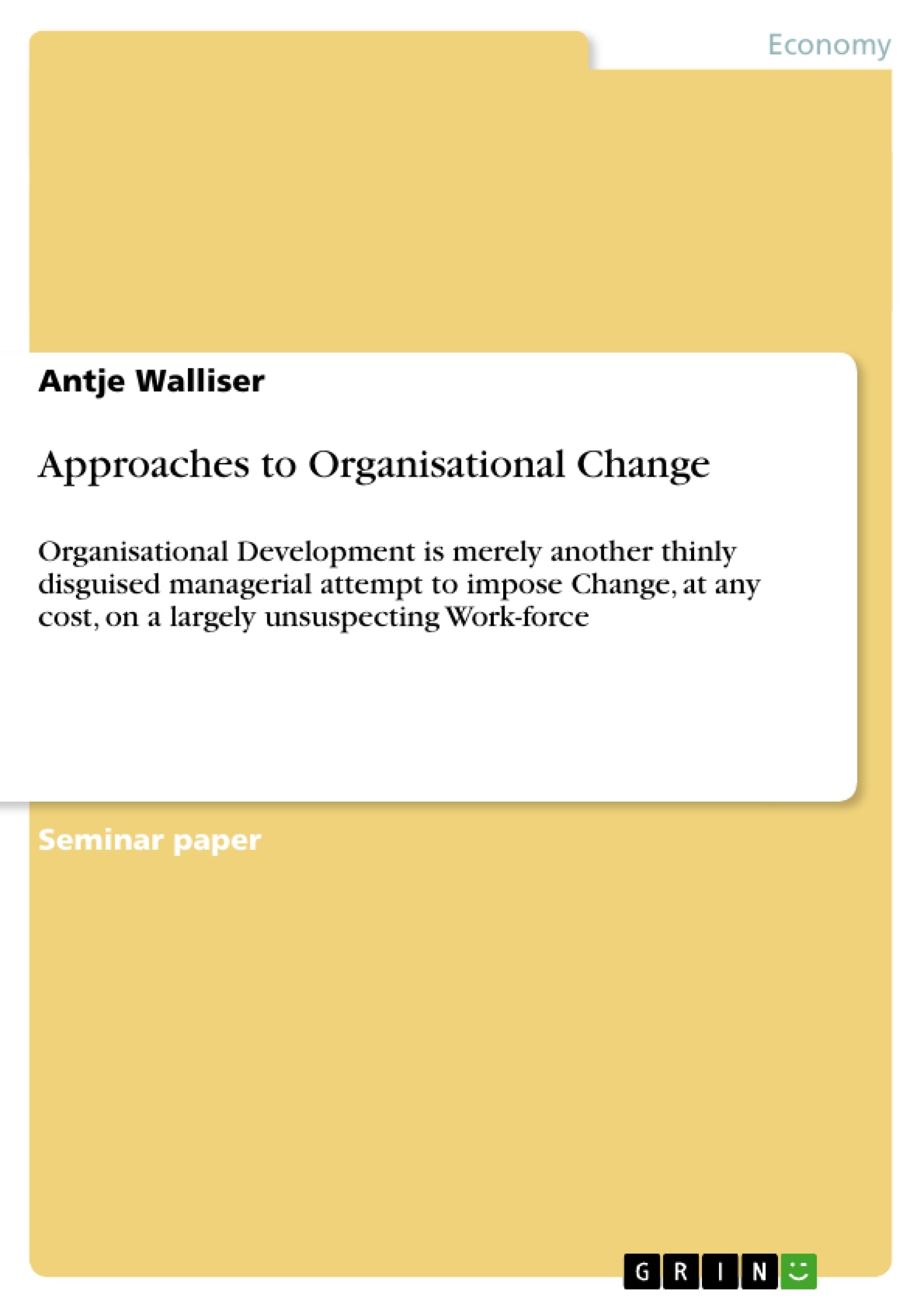Excerpt
Table of content
I. INTRODUCTION
II: CHANGE
External and Internal Forces for Change
Resistance to Change
III. APPROACHES TO ORGANISATIONAL CHANGE
1. Organisational Development (OD)
1.1. The Planned Approach
Action research
Three-step model
1.2. The Emergent Approach
1. 3. OD Intervention Methods
IV. CASE STUDY HILTI (Lichtenstein)
Statement by the Executive of the Logistics department (November 2001):
Statement by an employee and member of the Project Team (Nov 2001):
V. CONCLUSION
VI. Bibliography
I. INTRODUCTION
Organisations are part of a complex and erratic business world, which is in a continuous progress and change. Thus change has become a much debated topic and an inevitable aspect of organisational culture, with a lot of different approaches.
The debatable thesis challenges Organizational Development (OD) in particular. But before discussing this any further, the thesis should be analysed a little closer.
It is interesting to reflect, out of which perspective this statement was developed. It could be either from someone, who has a bird view on an organisation, or from an employee. It would be interesting to involve closer into the workforce perspective and to find out with the help of case studies, why OD was perceived as imposed change - if it was. However, this would go beyond the capacity of the essay.
The following piece of work shall create an understanding for the underlying rationales of the statement ‘OD is just ANOTHER attempt to IMPOSE change on the workforce’.
Initially different forces of change and forms of resistance are presented. Later, different approaches on organisational change are considered with the main emphasis on OD and thereafter, a case study on the company Hilti is described, in order to demonstrate an OD process. In the end, the arising issues regarding the thesis will be summarized after a short review, and a conclusion will be drawn.
II. CHANGE
External and Internal Forces for Change
Organisations are confronted with different forces driving change. There are external ones, such as globalisation, causing changes not only in a structural but also in a mental way; ever faster changing economic, global and technological developments and an increasingly diverse workforce. Moreover, internal forces can arise creating a demand for change, such as a declining effectiveness, a changing work climate and changing employee expectations.
Those external and internal forces are often counter dependent and again it becomes very clear that one of the burning issues for organisations, is the ability to successfully respond to change.
However the recognition of a need for change is still far away from implementing change successfully.
Resistance to Change
Depending on the change approach, it is probable that change efforts run into some form of resistance.
This resistance may arise from parochial self-interest, when employees are afraid to loose something and thus focus only on their own interests, rather than the organisations ones. This often results in political behaviour.
People will also tend to resist if they do not understand what consequences the change may have for them. Thus feel to be investing more than getting returned.
A low level of trust between the workforce and the managers easily creates misunderstandings. These have to be rapidly clarified by the management or resistance is probable consequence.
When organisational situations are assessed differently by the management and the employees, the reason is often a different level of information, causing a different analysis in turn leading to resistance.
If people are afraid of personal failure change or the change is too fast, they also tend to resist.
Different ways have been suggested in order to deal with resistance. To ‘encourage people to participate as partners in the change’ (Robbins H., Finley M. (1998): p.103) will increase commitment and reduce resistance. This participation can be direct, by asking and answering questions, or passive, through continuous communication and feedback on the process. To orientate people towards the future helps them to understand and to see outcomes. Overall it has to become also their change and letting employees drive the change vehicle allows them to determine its speed.
III. APPROACHES TO ORGANISATIONAL CHANGE
There are a number of ways how managers can cope with change, which all focus on the improvement of the business performance and competitiveness. A lot of approaches are extremely process orientated focusing on hard facts, such as numbers, profit analysis etc. instead of involving the employees. These approaches, such as the following, were and are quite common use, however often do not bring the wanted results in the long-term perspective.
At the end of 1800 Weber and later at the beginning of 1900 Taylor, developed an authoritarian approach to organisational management. Taylors’ approach was a scientific approach and mainly focused on technology and processes and stated that the human element had a minimum influence on production.
Thus, employees were neither provided with information, nor involved into any ideas for quality improvement or changes planned. Change was merely imposed on the unsuspecting workforce.
Over the years this emphasis shifted progressively more, with Mayo being one of the first to appreciate the workforce as one of the factors having an impact on successful organisational performance.
Then, in the mod-1980s, the movement of Total Quality Management (TQM) arose. Here, process measurement and controls play a very important role as means of constant improvement.
In the 1990s’ Business Process Re-engineering (BPR) had its heyday aimed at increasing organisational performance by boosting the effectiveness and efficiency of key business processes.
Other approaches were developed, however none really managed to balance the involvement of the process and cultural level, emphasising the integration of the employees into the change process, which the Organisational Development (OD) approach does.
[...]
- Quote paper
- Antje Walliser (Author), 2003, Approaches to Organisational Change, Munich, GRIN Verlag, https://www.grin.com/document/48503
Publish now - it's free























Comments